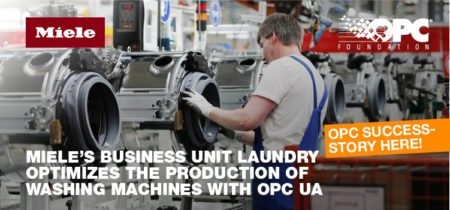Introduction
Miele is the world’s leading supplier of premium domestic appliances, as well as appliances for commercial use. Miele also produces cleaning, disinfection, and sterilization equipment for medical facilities and laboratories.
Founded in 1899, employing over 21,000 people worldwide, and represented in almost 100 countries, Miele garners annual sales of EUR 4.5 billion.
Why Does Miele Rely on Production Communication with OPC UA?
 “OPC UA is the communication protocol for Industry 4.0, with cross-manufacturer and cross-platform use. OPC UA has the crucial advantage that communication follows a uniform format, being robust and secure with OPC UA interfaces,” says Christian Stickling, Information Technology in Appliance, Miele.
“OPC UA is the communication protocol for Industry 4.0, with cross-manufacturer and cross-platform use. OPC UA has the crucial advantage that communication follows a uniform format, being robust and secure with OPC UA interfaces,” says Christian Stickling, Information Technology in Appliance, Miele.
Can Existing Systems Be Upgraded to OPC UA?
“The uniform interfaces can be used for different systems, which is a great advantage for existing production lines. Consequently, the time required for adaptations or the integration of devices and systems is significantly reduced. Our greatest advantage is that 100% of Miele’s suppliers now provide OPC UA-compliant products with OPC UA interfaces in machines and controllers.”
Keywords: ‘Data Security’
“The high security level of OPC UA is a main factor for Miele. Communication with OPC UA works according to the principle “secure by default”. All data is encrypted and transmitted securely. Under these security standards, our Laundry Business Unit assets and production data are transferred to Microsoft’s Azure Cloud.”
Manufacturing Washing Machine Aggregates with OPC UA
In 2018, Miele chose to rely on OPC UA in the press shop and body shop to produce sheet steel components for washing machines. In subsequent production steps, including welding, clinching, and bolting processes, these individual parts are assembled into a washing machine unit and housing. In final assembly, these and other individual parts are combined to form the finished washing machine. The goal of the OPC UA integration was to modernize and simplify data communication in production. Today, OPC UA standards are implemented when existing plants are remodeled; but new plants are already equipped with OPC UA from the factory.

Conversion To OPC UA In Just Three Weeks
The integration of the new communication level could only take place during the three-week plant vacation period, which meant the individual test series had to take place under real conditions of the running press plant. Within three weeks, the old system had to be dismantled, the new communication levels, including the OPC UA interfaces, had to be integrated, and the upgrade of the existing machinery, with adapters, had to be completed and tested.
“There was a Plan-B, but no going back.”
Failure would have resulted in immense licensing costs for previous software, as well as costs for rebuilding and redundancies. There was a plan B, but no going back. “When production started, without errors on Monday morning, we knew every stage of production had been successfully converted to the OPC UA communication standard,” explains Christian Stickling in retrospect.
Future-proof Operations
“We now have a simpler and more future-proof operation of production-related communications and have achieved monetary savings by not having to purchase special software licenses. This also results in faster troubleshooting, ensuring smooth operations.”
Read Complete Application Story Here
